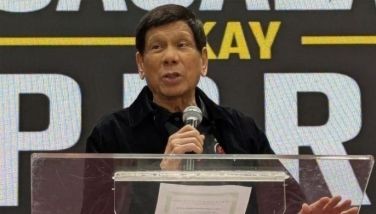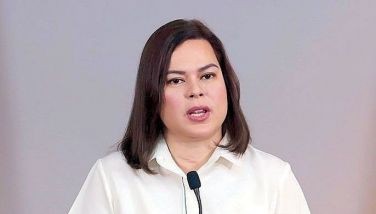An excellent move by the BSP
February 26, 2007 | 12:00am
Last week, the Philippines liberalized certain currency control rules which were in place for almost ten years. We view this as an economic milestone and an ultimate proof that normalcy has been brought back to our currency market. More importantly, it signifies that the country has indeed recovered from the prolonged debilitating effects of the 1997 financial crisis.
Among the steps undertaken by the central bank are:
• Raising the limit on banks’ long foreign currency position by 8x to 20 percent of their unimpaired capital (or $50 million, whichever is lower)
• Putting a limit on short forex position of banks equivalent to 20 percent of their unimpaired capital. Thus, the limit on banks’ long and short position will now be the same at 20 percent
• Doubling the annual ceiling on outward forex investment by residents without central bank approval to $12 million, and
• Raising the cap on individual’s forex purchases without supporting documents to $10,000 from $5,000.
By liberalizing these forex rules, our monetary authorities also delivered an important message to the investing community: Our economy has become strong enough to weather any risks related to the currency market. This may be just as important as our exit from the IMF program in providing a boost to investor confidence.
Putting the house in order
Implementing these liberal currency mechanisms is nothing extraordinary. We just returned to the relaxed state that we were in prior to the 1997 financial crisis. The crisis prompted the restrictions so as to abate the peso’s subsequent freefall. But the situation has now reversed. The peso has consistently strengthened for good reasons. Our fiscal house has been put in order, with the budget deficit under manageable levels. Meanwhile, our dollar reserves have been piling, thanks to strong dollar receipts from exports, large equity investments in the stock market by foreign funds, and the phenomenal contribution from OFWs and BPOs.
The peso has appreciated 2.1 percent year-to-date vs. the US dollar, the third best performing next only to the Thai baht and the Korean won.
Currency Rankings Price End-2006 23-Feb %Chg YTD
Major currencies vs. US dollar
Australian dollar 0.7897 0.7886 -0.1%
British pound 1.9637 1.9566 -0.4%
Euro 1.3212 1.3124 -0.7%
Swiss franc 1.2172 1.2381 -1.7%
Japanese yen 118.93 121.47 -2.1%
Asian currencies vs. US dollar
Thai baht 35.289 33.639 4.9%
Korean won 917.37 894.42 2.6%
Philippine peso 49.03 48.03 2.1%
Chinese yuan 7.8175 7.7439 1.0%
Malaysian ringgit 3.5236 3.496 0.8%
Indian rupee 44.28 44.21 0.2%
Singapore dollar 1.532 1.5338 -0.1%
Indonesian rupiah 8966.4 9070.5 -1.1%
Taiwan dollar 32.525 33.105 -1.8%
Source: Bloomberg, BSP
Earlier, we forecasted that the peso could reach P46 by yearend or early 2008. This early, with less than two months of the year gone, the peso could have reached the P47 level if not for the decisive and timely intervention of the Bangko Sentral ng Pilipinas (BSP). Our sources reported that the BSP bought at least $200 million dollars to protect the peso from breaching P48. With 10 months more to go, and with most of remittances coming in during the school opening and Christmas season, there is a lot more room for the peso to appreciate.
Dollar revenues from BPOs, based on industry estimates, are also seen at $2.5 billion this year and more than $3 billion next year. In addition, the government stands to receive some $509 million in proceeds from the sale of PTIC shares and should generate more from the planned sale of its shares in MERALCO. The privatization of the power sector should bring in even more dollars to the government coffers. In fact, the privatization of Transco alone could generate at least $3 billion.
Lastly, let us not forget the largely untapped potentials of the mining and tourism industries. These two industries should generate even larger dollar revenues for the country in the next few years and decades to come. Indeed, there are bright prospects for the country if we play our cards right.
In an earlier article (see Tinkering with Market forces, Jan. 29, 2007 issue), we cautioned policymakers against undertaking a one-sided approach in addressing concerns on the peso’s unabated strengthening. We were then apprehensive when we heard of the proposal to limit the banks’ oversold position as this went against market-oriented reforms and would be viewed negatively by investors. We also thought that the timing of such proposals was really way off, in light of the currency restrictions implemented by Thailand that rattled and turned investors away. Thus, it is with great relief and encouragement that we welcome and appreciate the central bank’s recent prudent and holistic approach.
Also, the timing has never been more perfect. The Thai market and the Thai baht have stabilized. The peso is at its six-year high, reaching as low as 48.03 last week. There were some initial market apprehensions on the planned currency rule liberalization, causing the peso to momentarily lose some ground. However, these fears were soon allayed and the peso stabilized. This only proves that we are now ready for a more liberalized currency regime.
BSP Governor Armando Tetangco, Jr. aptly said that the recent liberalization move will make the regulatory environment "more responsive to the needs of an expanding, more dynamic economy that has become increasingly integrated with global markets." We totally agree with him.
Congratulations to the Monetary Board and the BSP!
For inquiries and comments, you can email us at gime10000@yahoo.com or research@philequity.net or call Jerome Gonzalez or Ricardo Puig at 634-5038.
Among the steps undertaken by the central bank are:
• Raising the limit on banks’ long foreign currency position by 8x to 20 percent of their unimpaired capital (or $50 million, whichever is lower)
• Putting a limit on short forex position of banks equivalent to 20 percent of their unimpaired capital. Thus, the limit on banks’ long and short position will now be the same at 20 percent
• Doubling the annual ceiling on outward forex investment by residents without central bank approval to $12 million, and
• Raising the cap on individual’s forex purchases without supporting documents to $10,000 from $5,000.
By liberalizing these forex rules, our monetary authorities also delivered an important message to the investing community: Our economy has become strong enough to weather any risks related to the currency market. This may be just as important as our exit from the IMF program in providing a boost to investor confidence.
Putting the house in order
Implementing these liberal currency mechanisms is nothing extraordinary. We just returned to the relaxed state that we were in prior to the 1997 financial crisis. The crisis prompted the restrictions so as to abate the peso’s subsequent freefall. But the situation has now reversed. The peso has consistently strengthened for good reasons. Our fiscal house has been put in order, with the budget deficit under manageable levels. Meanwhile, our dollar reserves have been piling, thanks to strong dollar receipts from exports, large equity investments in the stock market by foreign funds, and the phenomenal contribution from OFWs and BPOs.
The peso has appreciated 2.1 percent year-to-date vs. the US dollar, the third best performing next only to the Thai baht and the Korean won.
Currency Rankings Price End-2006 23-Feb %Chg YTD
Major currencies vs. US dollar
Australian dollar 0.7897 0.7886 -0.1%
British pound 1.9637 1.9566 -0.4%
Euro 1.3212 1.3124 -0.7%
Swiss franc 1.2172 1.2381 -1.7%
Japanese yen 118.93 121.47 -2.1%
Asian currencies vs. US dollar
Thai baht 35.289 33.639 4.9%
Korean won 917.37 894.42 2.6%
Philippine peso 49.03 48.03 2.1%
Chinese yuan 7.8175 7.7439 1.0%
Malaysian ringgit 3.5236 3.496 0.8%
Indian rupee 44.28 44.21 0.2%
Singapore dollar 1.532 1.5338 -0.1%
Indonesian rupiah 8966.4 9070.5 -1.1%
Taiwan dollar 32.525 33.105 -1.8%
Source: Bloomberg, BSP
Dollar revenues from BPOs, based on industry estimates, are also seen at $2.5 billion this year and more than $3 billion next year. In addition, the government stands to receive some $509 million in proceeds from the sale of PTIC shares and should generate more from the planned sale of its shares in MERALCO. The privatization of the power sector should bring in even more dollars to the government coffers. In fact, the privatization of Transco alone could generate at least $3 billion.
Lastly, let us not forget the largely untapped potentials of the mining and tourism industries. These two industries should generate even larger dollar revenues for the country in the next few years and decades to come. Indeed, there are bright prospects for the country if we play our cards right.
Also, the timing has never been more perfect. The Thai market and the Thai baht have stabilized. The peso is at its six-year high, reaching as low as 48.03 last week. There were some initial market apprehensions on the planned currency rule liberalization, causing the peso to momentarily lose some ground. However, these fears were soon allayed and the peso stabilized. This only proves that we are now ready for a more liberalized currency regime.
BSP Governor Armando Tetangco, Jr. aptly said that the recent liberalization move will make the regulatory environment "more responsive to the needs of an expanding, more dynamic economy that has become increasingly integrated with global markets." We totally agree with him.
Congratulations to the Monetary Board and the BSP!
For inquiries and comments, you can email us at gime10000@yahoo.com or research@philequity.net or call Jerome Gonzalez or Ricardo Puig at 634-5038.
BrandSpace Articles
<
>
- Latest
- Trending
Trending
Latest
Trending
Latest
Recommended






























